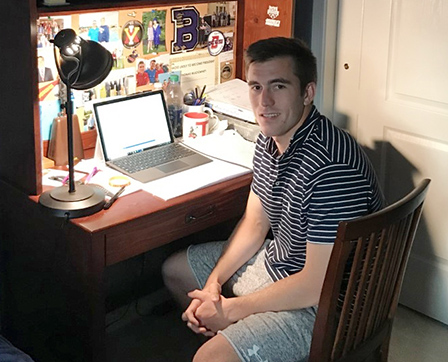Determining What Helps Migrants Integrate

Thomas Muldowney '21 is shown working on his summer research project on the successful migrant integration. Photo courtesy of Thomas Muldowney '21
This summer, Thomas Muldowney ’21 is working on a research project that involves a lot of number crunching—with the goal of finding out which policies actually benefit people.
Muldowney, an economics and business major, is trying to determine what factors influence successful migrant integration in Europe, a continent that has seen millions of refugees arrive, many by boat, from North Africa and the Middle East over the past decade.
Muldowney’swork, which is taking place under the auspices of the Summer Undergraduate Research Institute, was inspired when he took part ina summer 2019 trip to Europe led by Col. Valentina Dimitrova-Grajzl and Col. Tinni Sen, professors of economics and business, and Col. Howard Sanborn, professor of international studies. Studying the integration of migrants, Muldowney wrote in his SURI proposal, would help him learn more about the opportunities and challenges facing Europe today.
“Even though the European migration crisis was at its peak in 2015, European Union member states still have to find ways to successfully integrate the migrants that remain in their countries into society,” Muldowney wrote in an email.
Muldowney’s research is split into two parts. The first is a qualitative analysis of current European Union policies relating to migration and refugees, with case studies focusing on Greece, Spain, and Germany. The second is a quantitative analysis in which Muldowney examines how one set of variables affects another set.
For the second part, he’s gathering an exhaustive data set of explanatory variables such as gross domestic product per capita, urban versus rural population percentages, etc., for 50 European countries and pairing it with another set of dependent variables that include the unemployment rate of migrants by country, the unemployment gap between native and foreign-born workers by country, and the percentage of adults who want less migration in their country.
To put all of these numbers together and understand how one set of factors influences the other, Muldowney is using software called Stata, which is often used for statistical analysis in the social sciences.
“The most interesting aspect of my research is the research process itself,” wrote Muldowney, who hopes to commission into the Navy.“Trying to relate variables such as GDP per capita, attitudes toward migrants, education levels, and people's level of trust in each other and EU institutions in order to figure out how well migrants can be integrated into society is very complex. I had to learn this coding software called Stata that helped me to compile the data I collected and use it to produce results that can then be interpreted to answer my main research questions.”
He's also had to face the challenge of working from home in Northern Virginia and communicating remotely with Dimitrova-Grajzl, his faculty mentor. “I am missing the face-to-
face interaction with Col. [Dimitrova-Grajzl]and we have to resort to phone and Zoom calls, where even sometimes it is hard for me to communicate a question or problem I have or get an answer that makes sense to me,” Muldowney commented.“But we have made it work, and I think it has been a great experience.”
For her part, Dimitrova-Grajzl sees Muldowney’s work as important to the creation of public policy that can help migrants integrate more smoothly into their adopted countries. “We have seen a rise of populism in a lot of European countries, partly driven by the migration crisis in the 2010s,” she commented. “Understanding what determines people’s attitudes toward immigrants can help counter some of those populist trends.”
-Mary Price
-VMI-
.svg)
.png)